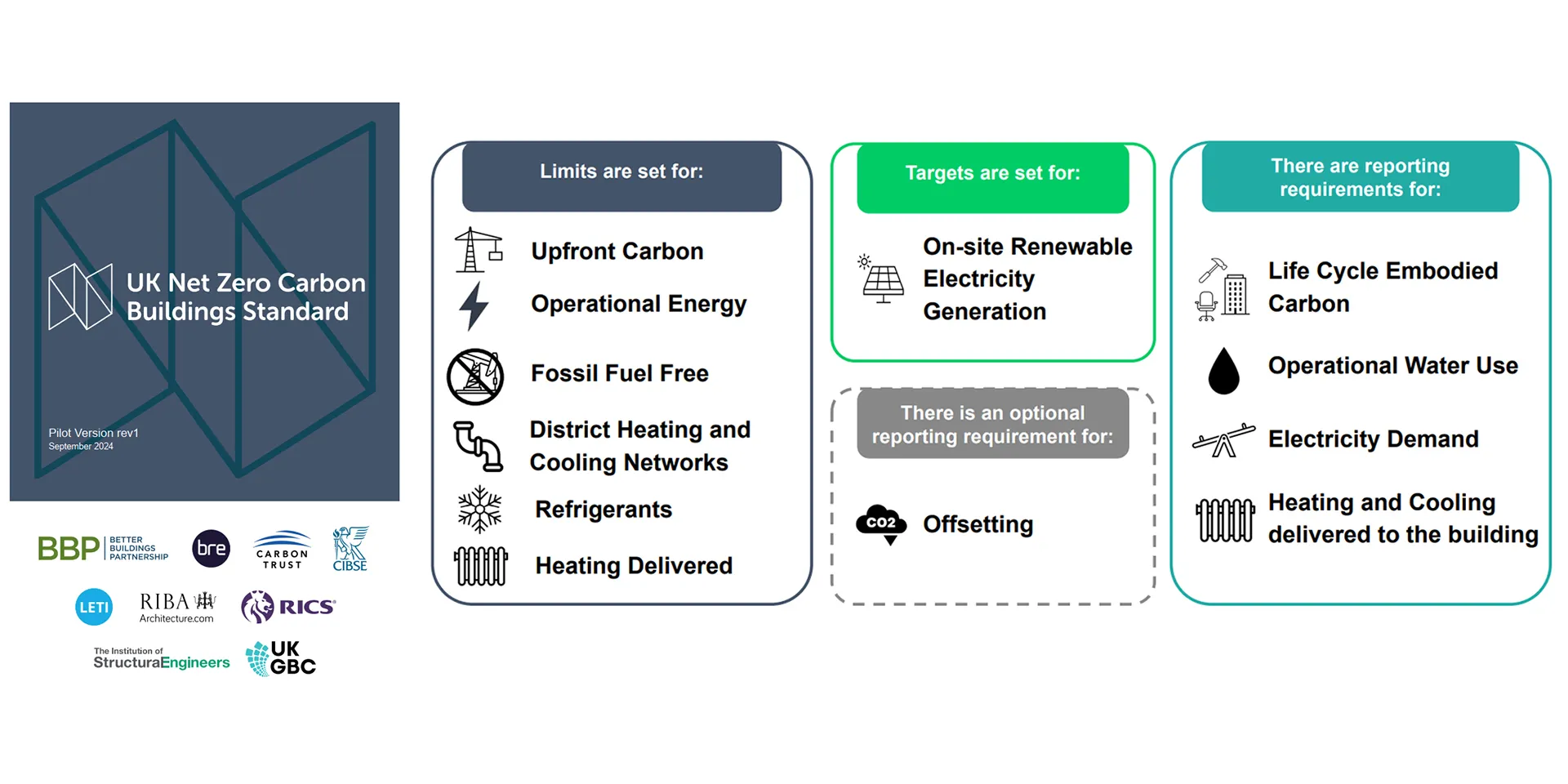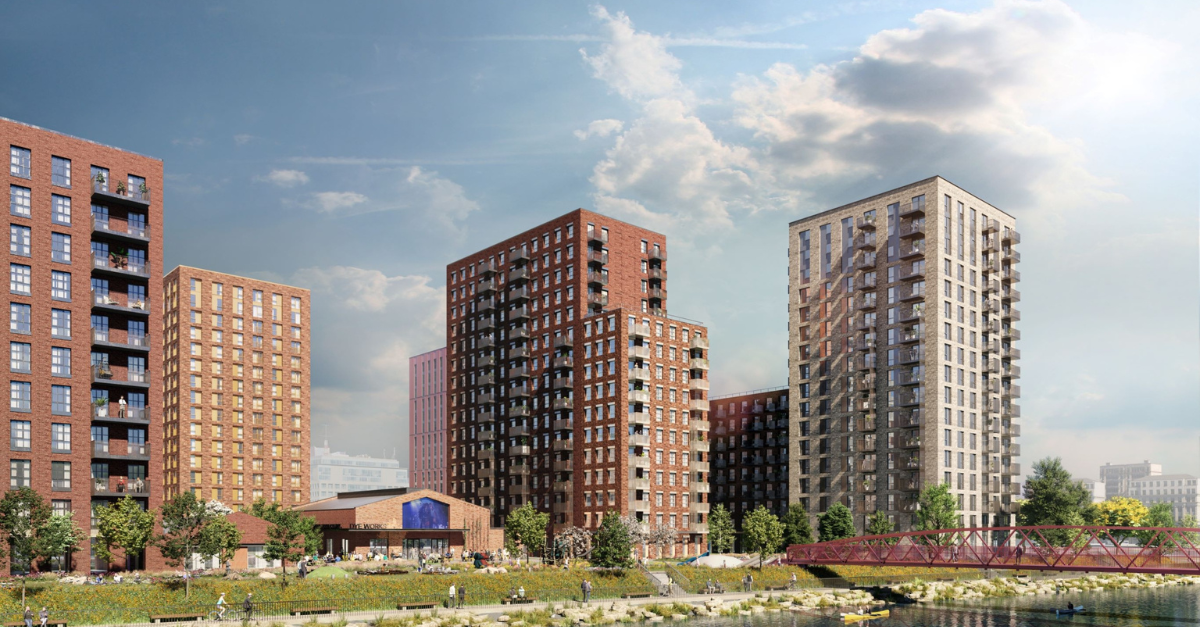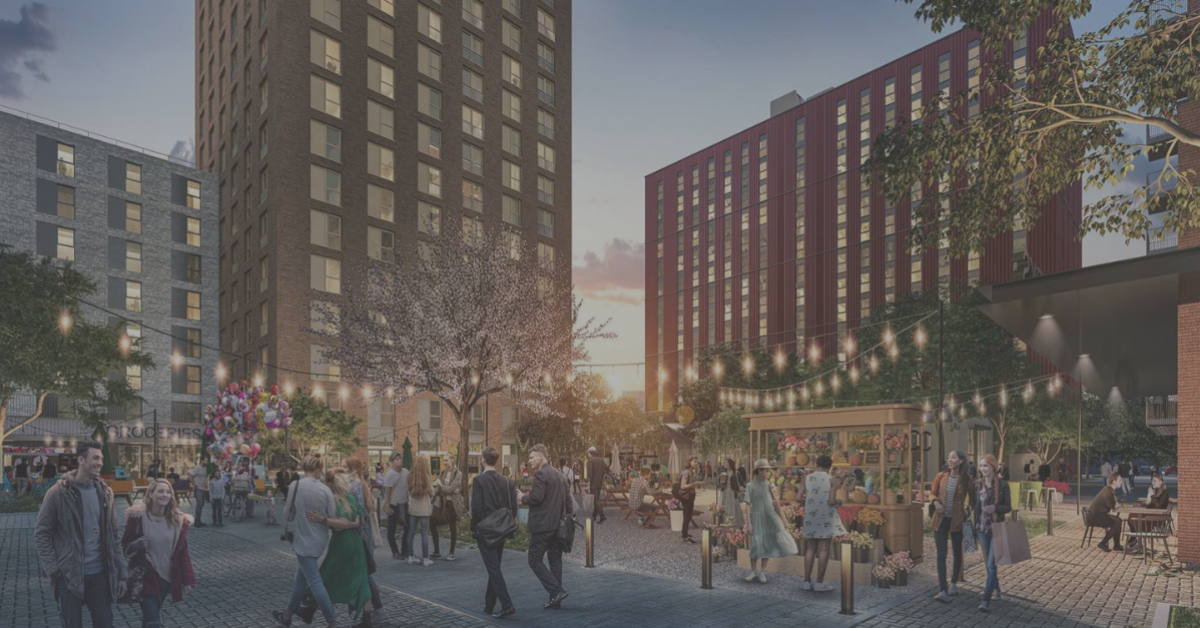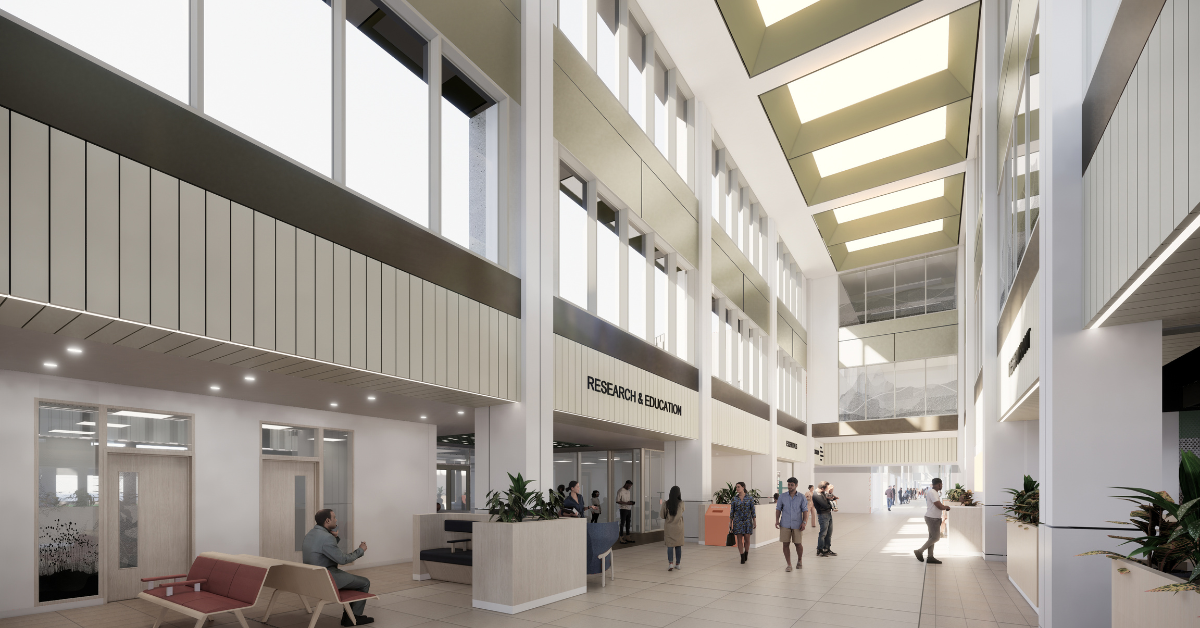News
UK's Net Zero Carbon Building Standard
Building for the Future: Navigating the UK Net Zero Carbon Building Standard

The UK Net Zero Carbon (UKNZC) Building Standard is an initiative that aims to tackle climate change. The pilot version of the Standard launched in September 2024. With the goal of delivering Net Zero Carbon Buildings by 2050, this voluntary standard sets ambitious new benchmarks for the built environment.
The Standard adopts both a phased approach and sector-specific targets, understanding that achieving net zero carbon emissions in buildings is a long-term goal and requires a phased approach, but also that different building sectors have unique characteristics and challenges in achieving net zero carbon emissions, meaning there are also sector-specific targets.
Consolidating existing standards and guidelines from organisations such as the BSI, UKGBC, LETI, RIBA, RICS, and CIBSE, The Standard establishes a unified process for achieving net-zero buildings by addressing carbon emissions across new developments and existing structures. The Standard covers retrofits, renovations, and replacements, and provides a framework for significantly reducing the carbon footprint of buildings across all sectors.
“Organisations and clients across all sectors are setting bold net-zero ambitions in line with their ESG commitments. However, the real challenge lies in delivering on these goals in a transparent and measurable way. Buildings play a critical role in this effort, both in understanding their environmental impact and achieving meaningful carbon reductions. The UKNZC Building Standard provides a clear, structured framework that leverages industry expertise to support this transition. Its introduction is a welcome step toward a more sustainable built environment.” Nick Hayes, Head of ESG & Sustainability, shared.
Overview of The UKNZC Building Standard
As buildings account for around 40% of the UK’s total energy consumption and 23% of greenhouse gas emissions, The UKNZC Building Standard applies to a broad range of building types, across residential, commercial, and public sectors, in attempt to reduce those emissions, and make the shift to a more sustainable environment.
Unlike many previous industry initiatives, the UKNZC Standard takes a comprehensive and holistic approach to assess a building’s carbon impact, considering both embodied and operational carbon emissions. This ensures that carbon reduction is not treated as a one-off effort, but rather as an ongoing commitment spanning the entire lifecycle of a building.

Key Components of the Standard
The core objectives of the UKNZC Building Standard focus on reducing both embodied and operational carbon emissions across the entire life-cycle of buildings. It emphasises genuine carbon reduction over offsetting, transparency through independent validation, and encourages innovation and collaboration to achieve a sustainable, net-zero carbon built environment. Limits and reporting metrics are proposed for various key components, which become progressively more stringent each year, which in turn incentivises early action to reduce energy consumption. The proposed targets are subject to third-party verification to confirm that the buildings meet the requirements. Each component targets a critical aspect of carbon reduction and sustainability, ensuring that every aspect of a building’s emissions is considered:
The Standard currently provides benchmarks for Upfront Embodied Carbon, referring to the emissions associated with the materials and construction processes up to the point of building completion. The limits vary based on the building type and reportable work (new build, retrofit, etc.). Future versions of the Standard are expected to include limits for Whole Life Embodied Carbon, which encompasses embodied emissions throughout a building’s life cycle, including demolition and disposal. There are also reporting requirements for the assessment of both lifecycle (whole life) and upfront embodied carbon.
The Standard sets limits for Annual Energy Use Intensity (EUI), which must be demonstrated using measured data from the building in use. Similarly to embodied carbon, these limits vary depending on the sector and building type. The Standard also requires annual operational carbon emissions and the energy intensity of specific energy end-uses to be reported for some building types. While there are no pass/fail limits for water usage, the Standard requires reporting of annual operational water use, water use intensity, and water emissions intensity.
The Standard sets a limit on the Global Warming Potential (GWP) of refrigerants used in buildings, capped at 677 kgCO2e/kg, equivalent to the GWP of the refrigerant R32. If the total GWP of refrigerants in a building exceeds 3,000 kgCO2e (equivalent to 4.4 kg of R-32), annual emissions from refrigerant leakage for products regulated by the Kyoto Protocol must be reported. These limits will help existing regulation by phasing down fluorinated gas usage and promote the push towards ‘natural’ refrigerants with lower GWPs, such as CO2 or propane.
The Standard requires building projects to track and report electricity usage patterns. Although there is no specific pass or fail targets yet, projects must report key data points, such as the date, time and electricity demand for periods representing the 99th, 50th, and 1st percentiles of energy use. Although the pilot version of the standard focuses on reporting, future versions may introduce specific targets, such as limits on peak winter electricity demand.
The Standard emphasises on measuring and reporting data, both for individual buildings and district systems, which are crucial for transparency and verification of net-zero claims. Centralised systems, which serve multiple buildings, can be more efficient and deliver lower adverse environmental impacts than individual systems. The Standard sets carbon intensity limits (kgCO₂e/kWh) for heating and cooling, with stricter benchmarks for new systems and requirements for reporting annual energy use and emissions.
The Standard emphasises the use of on-site renewable generation as a crucial strategy for reducing a building’s carbon footprint and achieving net-zero targets. This aligns with broader efforts to decarbonise energy supply and reduce reliance on fossil fuels. The Standard includes specific targets for the annual amount of on-site renewable electricity generation that a building must achieve, which varies depending on the region and the type of building. The standard acknowledges that not all buildings may be able to meet the on-site generation targets in exceptional circumstances due to site constraints, and limited roof space for solar panels etc.
This is a central requirement of the standard. All buildings are able to operate free from the use of fossil fuels, meaning eliminating the use of fossil fuels such as grid-supplied gas, oil and coal for the purposes of space and water heating, and cooking. Eliminating fossil fuel use is essential to delivering net-zero buildings, but it must be complemented by other strategies, such as reducing overall energy demand and integrating renewable energy.
The UKNZC Building Standard does not outline specific methods to achieve its goals but instead sets clear benchmarks, which can foster innovation and encourage tailored solutions.
The Standard creates opportunities for us to work with clients, architects, and other stakeholders to deliver integrated, efficient, and forward-thinking designs. As the industry embraces this shift towards decarbonisation, our experience in MEP design, Sustainability, and ESG principles positions us to help our clients follow the pilot standard and drive meaningful change.

Strategies for Implementation
At Wallace Whittle, we believe that achieving net-zero carbon starts at the very beginning of a project. By integrating sustainability principles early into the design and planning stages, we ensure that every aspect of the building process is aligned with net-zero goals. This involves selecting sustainable materials, optimising building fabric for energy efficiency, sourcing materials locally, and incorporating renewable energy solutions from the outset.
We work closely with our clients to ensure these principles are part of the foundation, ensuring long-term sustainability from day one. Some of the strategies include:
By integrating sustainability principles into the design and planning stages, we ensure that every aspect of the building process is aligned with net-zero goals. Such as selecting sustainable materials, optimising building fabric, and incorporating renewable energy solutions from the outset. At Wallace Whittle, we work closely with our clients to ensure these principles are part of the foundation, ensuring long-term sustainability from the get-go.
Meeting net-zero carbon targets requires collaboration across all disciplines — architects, engineers, contractors, and developers. We foster this collaboration by sharing knowledge, best practices, and innovative solutions and understand that achieving these ambitious goals requires a collective effort.
To meet the targets set by the UK Net Zero Carbon Building Standard, investment in training and education is essential. We are committed to upskilling the next generation of engineers and professionals to design and calculate net-zero carbon buildings. We recognise that addressing the skills gap is critical, we therefore provide ongoing training to our team across the business with our WW:Academy. However, we also recognise that this is a wider industry challenge that requires policy support and investment at all levels, including funding for education and skills development.
Government incentives, grants, and streamlined planning processes are crucial to supporting the transition to net-zero carbon buildings. We actively advocate for such policy support and align our work with the evolving regulatory landscape. With the new Labour 2024 Budget placing emphasis on sustainable initiatives, we are aiming to leverage these resources.
We understand that to achieve net-zero emissions, we must think beyond efficiency and focus on sufficiency by designing buildings that meet the needs of the occupants without over-consuming resources. Many existing standards optimise “business as usual” approaches, which can still result in over-consumption and continued emissions. By rethinking our approach to consumption and resource use, we can design and deliver truly sustainable buildings that make meaningful contributions to carbon reduction goals.

As the UK Net Zero Carbon Building Standard paves the way for a more sustainable environment, it sets ambitious yet achievable benchmarks for reducing carbon emissions across all sectors. While the path to net-zero demands collaboration, innovation, and long-term commitment, it also opens unprecedented opportunities for forward-thinking consultancies like Wallace Whittle to lead by example.
The UKNZC Building Standard is more than a framework; it is a call-to-action. Through commitment and collaboration, we can meet these ambitious goals and create a built environment that better benefits buildings, people and the planet!
Connect with our ESG or Sustainability team to discover how we can help your business meet its ESG goals and implement more sustainable solutions, get in touch today.

Felipe Tibabuzo Castro
Sustainability Associate

Cameron Duff
Sustainability Consultant


